It’s time to learn how to tape handlebars. Properly.
Why would we waste our time writing an article about bar tape? All you do is wrap it around the bar. Everyone knows how to do that. Anyone who can’t do it doesn’t deserve to ride a bike.
Sorry to break the news to you, Mr. Smartypants, but not everyone knows how to wrap a bar. In fact, it’s one of the most common things I see done wrong on bicycles. If you’ve wrapped 1,000 bars before and can do it in your sleep, read no further – this article has nothing to offer you. If, however, you’ve never done it – or have always wondered what the “right” way is – read on.
This article will cover road drop handlebar taping. In a separate article, we will cover aero bar and base bar taping procedures.
Getting Started
Before we begin, I must state that this is NOT the only way to wrap a bar. If you have a better way, be my guest. This method has come from years of practice and speaking with other mechanics around the world, including the man that some call the best mechanic in the world, Faustino Munoz. I had the pleasure of meeting the man himself at the 2011 Tour de France, and his work was nothing short of outstanding. He tunes bikes with a combined precision and speed that is reminiscent of a professional musician playing a million-dollar violin in front of a crowded theater. He’s that good.
I like this taping method because it:
1. Works with all shifter designs
2. Doesn’t leave any exposed handlebar around the hoods
3. Stays put for a long time, assuming the wraps are done sufficiently tight
4. Looks good
For this demo, I’m using my favorite tape – Zipp Service Course CX. Yes, it’s sold as a cyclocross tape, but I think that’s missing at least 50% of the market (triathletes). It’s very grippy, has a great tactile feel, works well with or without gloves, and is generally fantastic.
How often should you replace your bar tape? If the interval at which you currently replace your tape is measured in years – that’s not often enough. In fact, that’s plain gross. You replace your running shoes and wash your socks, don’t you? Given all of the sweat, water, salt, sports drink, and other nasty things we put on our bikes, tape should be replaced at least annually. That’s a bare minimum. Of course, this will also depend on how many bikes you own and how much you ride each of them. If you ride exclusively on one bike, it probably deserves fresh tape every few months.
To begin, I’m starting with a bare bar:
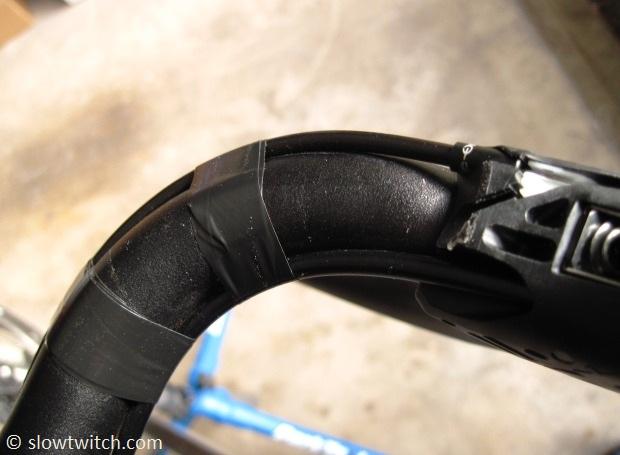
SLIDESHOW
Some bars and shifters route cables differently. My bike has Shimano 105 shifters and a Zipp Service Course SL bar. As you can see in the photo above, one housing routes behind the bar, and one routes in front of the bar. Some setups allow for two cables to run in the front. I usually just pick the routing that allows the cables to run smoothest and with the most gradual bends. As you can see, I secure the housings with electrical tape – this keeps them in place and makes bar tape wrapping easier.
The next step is critical if you want to be a super-pro bar wrapper. You must place your electrical tape on the stem like this:
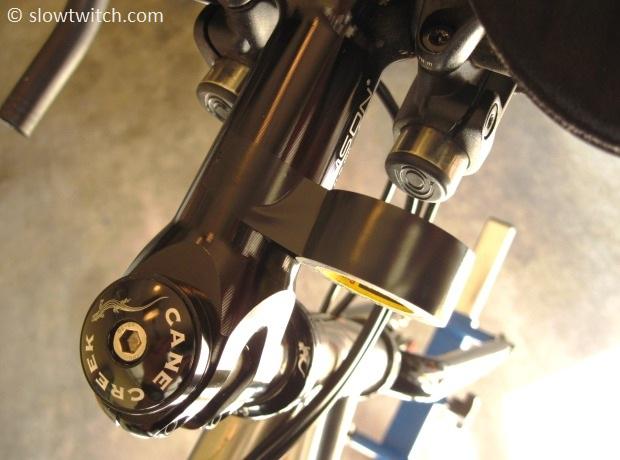
This leaves it ready for you to use later. Trust me on this one – you’ll need both hands to wrap the bars, and you want the tape to be handy. As an aside, the best tape I’ve found (at least in the US) is 3M Super 33+. The cheaper tapes are just that – cheap. They don’t adhere as well, don’t stretch as much, and generally don’t work as well as Super 33.
The final pre-wrapping step is this: Cut a small piece of tape that will wrap behind the brake/shifter hood. The length depends on your shifter, but somewhere in the ~8cm range is usually appropriate. Place it behind the hood like so:
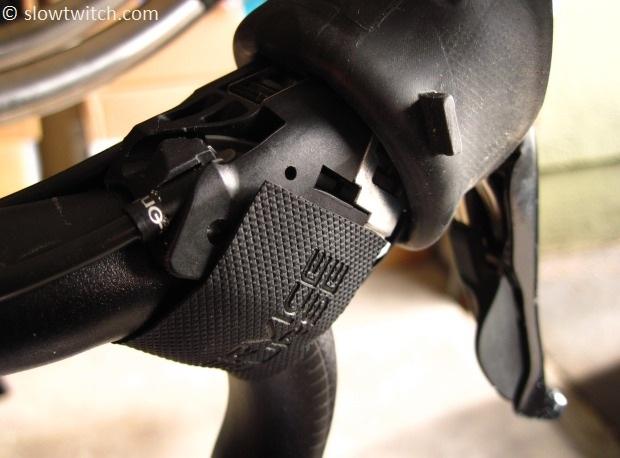
In the photo above, you’ll notice that there is a rectangular rubber protrusion on the back side of the hood. You may also notice that there’s a similar size cutout in the shifter body. You want these two to cozy up with each other. Different brand shifters have different sizes and shapes of cutouts, but the intent is the same – to hold the rubber hood in place. The important point for this demo is that you don’t cover up these holes with bar tape. My small segment of tape ended up at 7cm; you want it as long as possible, without covering up any holes.
Now it’s time to begin the actual taping. Insert about an inch (2-3cm) of tape in to the end of the bar:
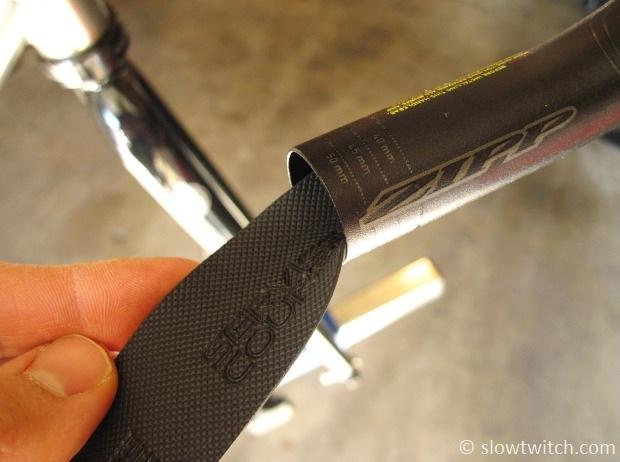
Now begins the great debate. Which direction to wrap the tape? Clockwise? Counterclockwise? Or is it directional-by-hemisphere, similar to the way toilets flush?
I’ll leave this decision to you. I’ve heard adamant arguments on both sides. Don’t worry about it. The most important thing is that you make the wraps tight enough. In my experience, that is what keeps the bar tape from unraveling – not the direction you wrap the tape.
I personally like to wrap the tape inwards. On the right drop, that means counterclockwise; on the left, clockwise. If you really want to get geeky, wrap the tape in the direction that you’ll more likely pull to tighten it while riding. If you pull more ‘up-and-in’ while sprinting in the drops, wrap like I do. If you tend to rest your hands and ride in the drops for long periods (pulling the tape ‘over-and-out’), wrap the other direction.
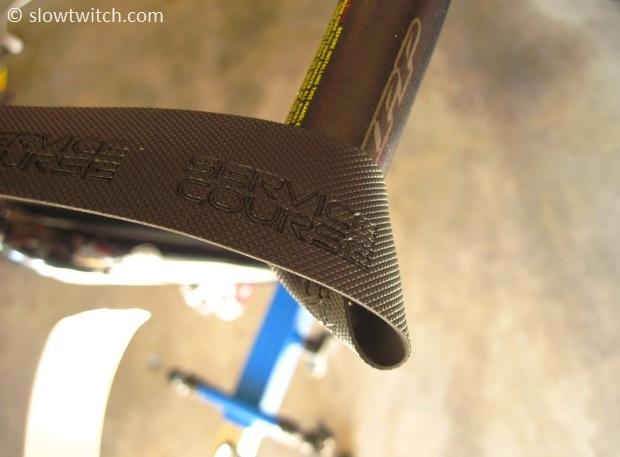
My first wrap is pictured above. You want the tape logos to be readable from the rider’s perspective.
Second wrap:
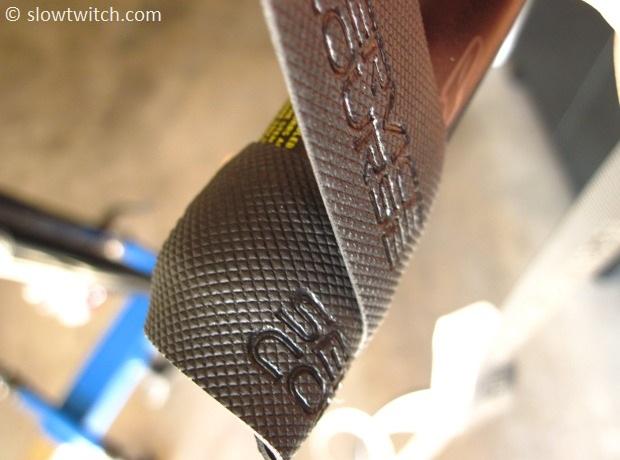
This is where you really get the ball rolling. You want to overlap the previous wrap by about 1cm, give or take. Pull each wrap what I call “very snug”. You don’t want to pull the tape so hard that you break it, but you definitely want it taut.
From there, keep wrapping. Try to keep the width of the wraps as consistent as you can.
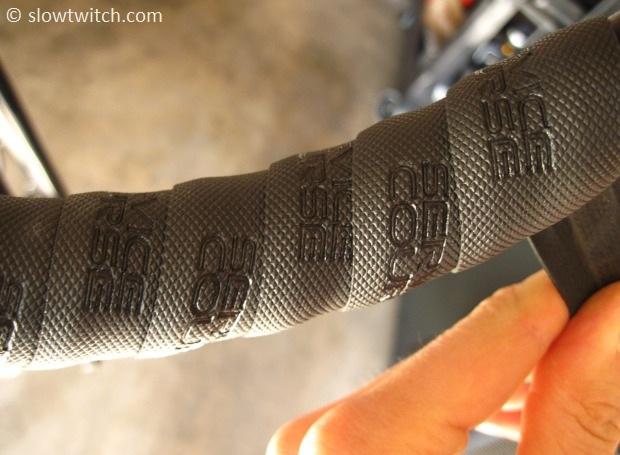
The toughest part is wrapping around the hood. Wrap until the amount of bar left exposed is less than the width of the tape:
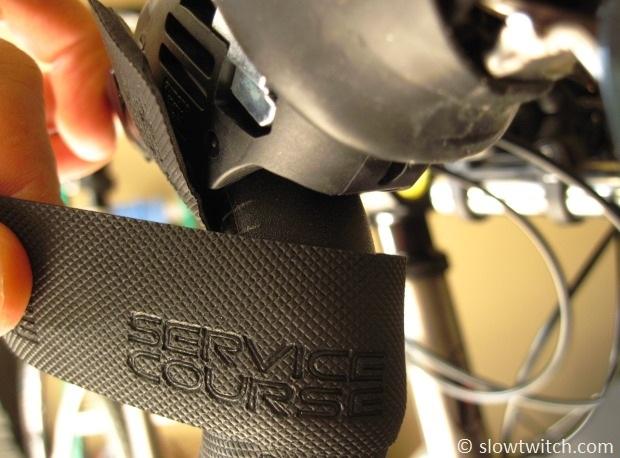
Next, we’re going to go behind the hood. Be sure that your small piece of tape behind the hood is situated correctly.
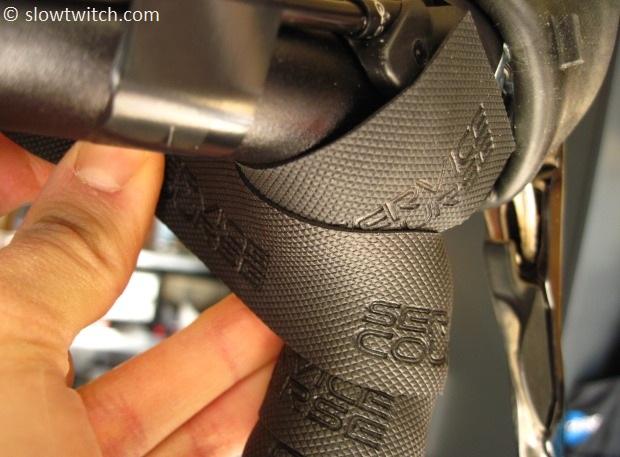
You wrap behind the hood, then up-and-over.
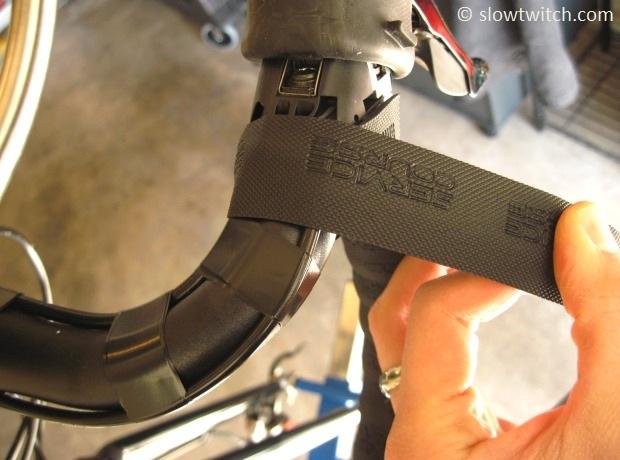
Resist the temptation to make this wrap too far forward. Wrapping further forward is easier (it holds the tape better), but can result in a lumpy hood with so much material piled up underneath. This is arguably the most important wrap of the whole process. I make sure it is very snug, and wrap it as far back as I can while still getting a reliable hold.
Next, pull the tape down-and-behind the hood.
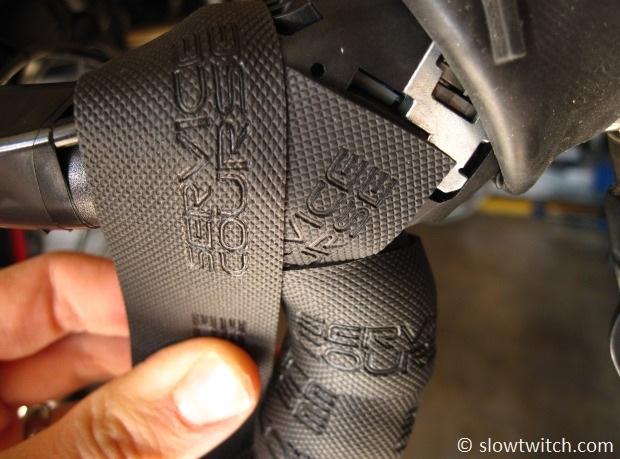
The photo above illustrates exactly why we used that small segment of tape behind the hood. Notice the V-shaped intersection of the tape wraps – if we didn’t have the piece of tape behind it, there would be a little triangle of exposed bar once we finish and roll the hoods back. It is sometimes possible forego the extra tape and avoid exposed bar, but it really depends on the bar shape, hood style, and how lucky you get.
Now, bring the tape down and around the front of the hood, covering up that final exposed portion of the bar:
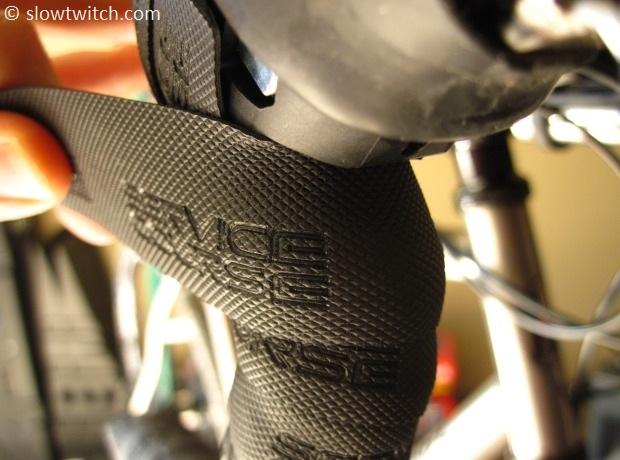
Next, wrap around the hood, and under the bar:
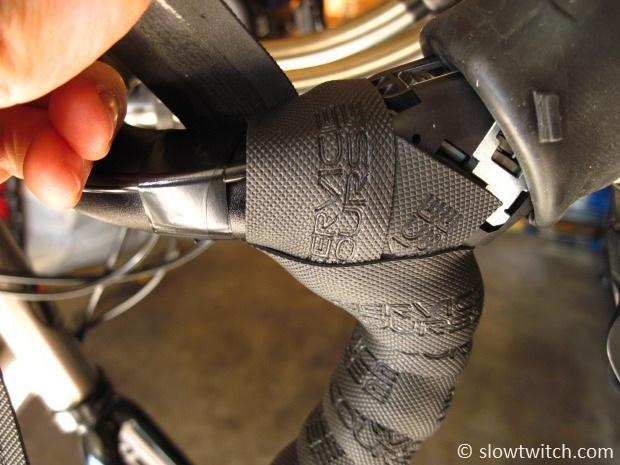
We can resume taping normally along the tops of the bar:
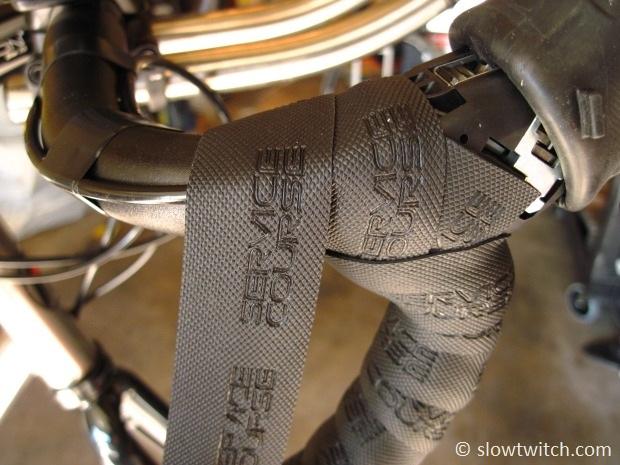
Now we’re nearing the termination point. The location at which you stop taping is up to you. It mostly depends on whether or not you have any accessories on your bar – lights, computers, aerobars, etc. My bike has clip-on aerobars, so I stop the tape earlier than I would without them.
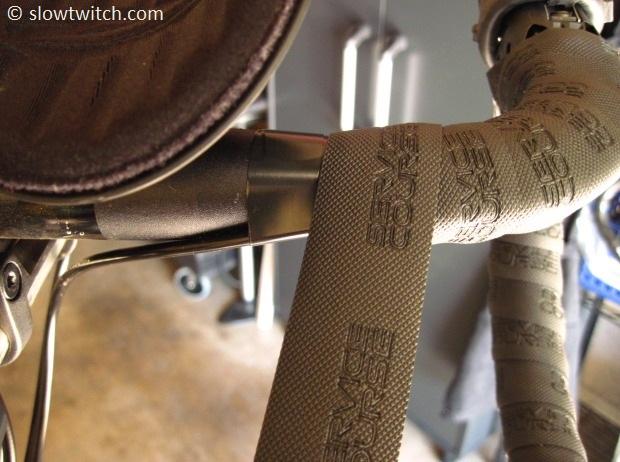
I terminate my bar tape so it lines up exactly with the end of my last wrap of electrical tape (the electrical tape that is holding the cable housings down).
Use scissors to cut the tape off. You’re cutting the tape at an angle, but the result is a straight end (perpendicular to the handlebar).
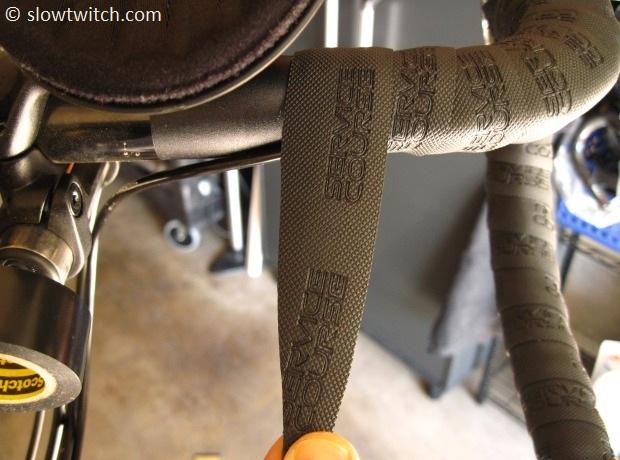
You will likely have to trim this end a few times to make the length perfect. Once you’re ready, wrap the tail end of the tape around, grab your electrical tape (which is conveniently located on your stem), and secure the end of the bar tape.
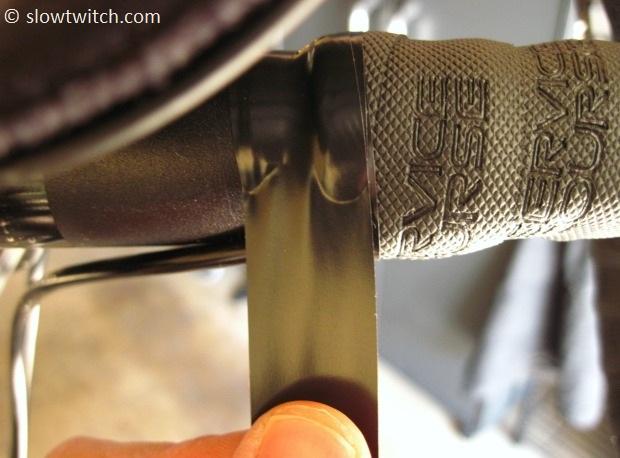
Don’t be shy with the electrical tape. How many wraps do you need? Probably more than you think. You don’t need twenty, but you need more than two. Call it five or six – then pull and break the tape.
Now we need to install the bar-end plug. Before you go carelessly putting plugs in, firmly grab the end of the bar. You want to hold the tape in place. If you jam the plug in without holding the tape, you can ruin your lovely work by unraveling your first critical wrap.
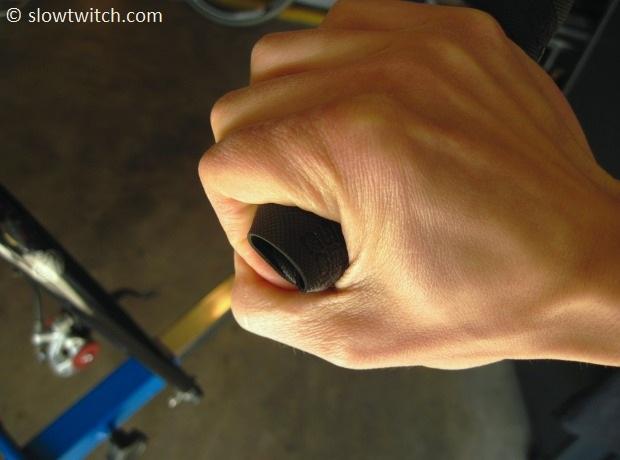
Slowly and firmly push the plug in with your other hand.
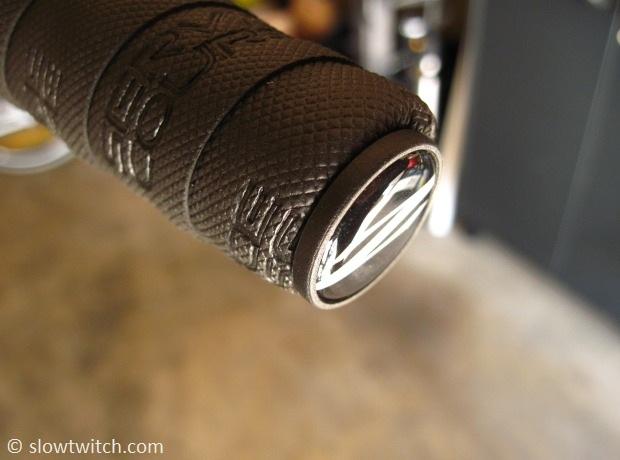
Before you fold the hood back, double check that all of the holes and slots are free and clear. If one is covered up, you can use scissors or a flat razor to carefully trim the extra bar tape away. The hood should lay clean and flat when you’re done.
If you messed anything up – try, try again. The Zipp Service Course CX tape has a gel backing that is sticky, but not permanent. If you need to adjust the width of your wraps, you can usually backtrack without too much trouble. The real key – as with most things – is practice.
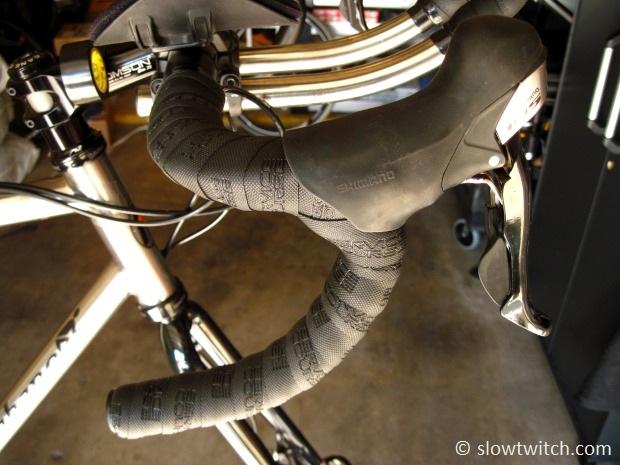
Contact: Lily Zhang
Phone: 0086 17521331046
Tel: 0086 17521331046
Email: zzsales01@163.com
Add: No 598 puxiu road Shanghai China